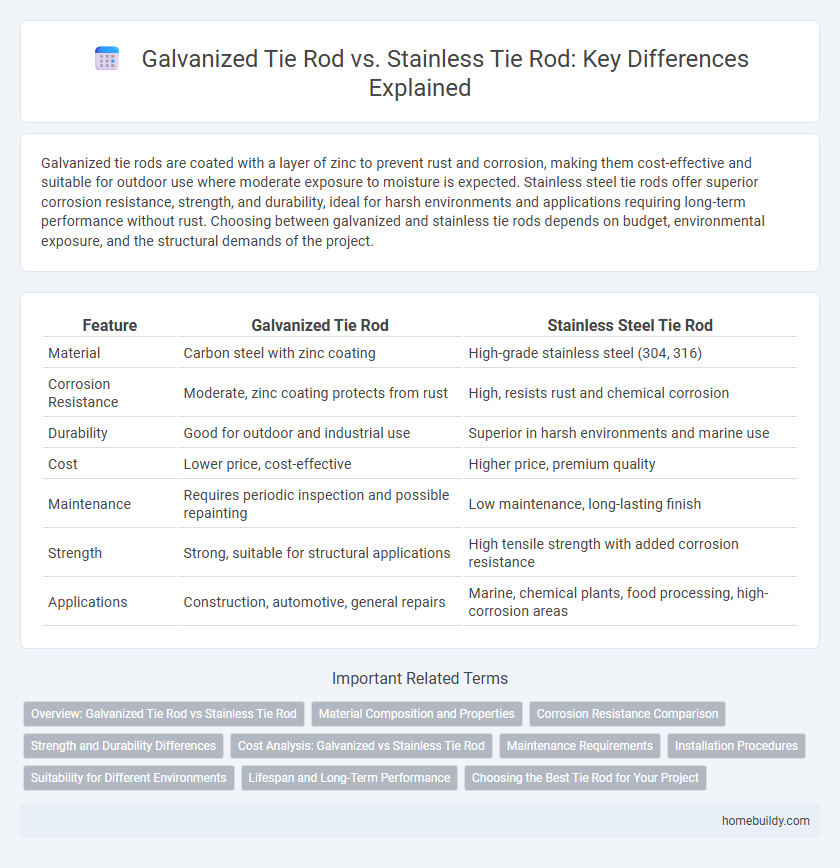Galvanized tie rods are coated with a layer of zinc to prevent rust and corrosion, making them cost-effective and suitable for outdoor use where moderate exposure to moisture is expected. Stainless steel tie rods offer superior corrosion resistance, strength, and durability, ideal for harsh environments and applications requiring long-term performance without rust. Choosing between galvanized and stainless tie rods depends on budget, environmental exposure, and the structural demands of the project.
Table of Comparison
| Feature | Galvanized Tie Rod | Stainless Steel Tie Rod |
|---|---|---|
| Material | Carbon steel with zinc coating | High-grade stainless steel (304, 316) |
| Corrosion Resistance | Moderate, zinc coating protects from rust | High, resists rust and chemical corrosion |
| Durability | Good for outdoor and industrial use | Superior in harsh environments and marine use |
| Cost | Lower price, cost-effective | Higher price, premium quality |
| Maintenance | Requires periodic inspection and possible repainting | Low maintenance, long-lasting finish |
| Strength | Strong, suitable for structural applications | High tensile strength with added corrosion resistance |
| Applications | Construction, automotive, general repairs | Marine, chemical plants, food processing, high-corrosion areas |
Overview: Galvanized Tie Rod vs Stainless Tie Rod
Galvanized tie rods feature a zinc coating providing corrosion resistance primarily suitable for outdoor or industrial environments where exposure to moisture is moderate. Stainless tie rods, made from chromium-rich alloys, offer superior resistance to rust, heat, and chemical exposure, making them ideal for harsh or marine conditions. Choosing between galvanized and stainless tie rods depends on the specific environmental factors and budget constraints of the construction or mechanical application.
Material Composition and Properties
Galvanized tie rods are typically made from carbon steel coated with a zinc layer, which provides corrosion resistance suitable for outdoor and industrial applications. Stainless steel tie rods contain alloys primarily of iron, chromium (usually above 10.5%), and nickel, offering superior corrosion resistance, higher tensile strength, and better durability in harsh environments. The zinc coating on galvanized tie rods can wear off over time, whereas stainless steel maintains its integrity without additional treatment.
Corrosion Resistance Comparison
Galvanized tie rods feature a zinc coating that provides effective corrosion resistance in environments with moderate humidity and exposure to outdoor elements, preventing rust and extending durability. Stainless steel tie rods offer superior corrosion resistance due to their chromium content, which forms a passive oxide layer protecting against rust, particularly in highly corrosive or marine environments. For applications requiring long-term exposure to harsh or saline conditions, stainless tie rods significantly outperform galvanized options in maintaining structural integrity.
Strength and Durability Differences
Galvanized tie rods feature a zinc coating that offers strong corrosion resistance, making them suitable for outdoor and industrial environments where rust prevention is essential. Stainless steel tie rods provide superior strength and enhanced durability due to their alloy composition, which resists corrosion, pitting, and high temperatures more effectively than galvanized options. The choice between galvanized and stainless tie rods depends on specific structural load requirements and environmental exposure, with stainless steel typically preferred for long-term durability in aggressive conditions.
Cost Analysis: Galvanized vs Stainless Tie Rod
Galvanized tie rods generally offer a lower initial cost due to the zinc coating process, making them a budget-friendly option for standard applications. Stainless tie rods, while more expensive upfront, provide superior corrosion resistance and durability, reducing maintenance and replacement expenses over time. Cost analysis should weigh upfront investment against long-term performance, especially in harsh environments where stainless steel's longevity can offset higher material costs.
Maintenance Requirements
Galvanized tie rods require regular inspection for coating integrity and may need periodic touch-ups to prevent rust, especially in harsh environments. Stainless steel tie rods have significantly lower maintenance needs due to their inherent corrosion resistance, eliminating the need for protective coatings. Choosing stainless steel reduces long-term maintenance costs and downtime associated with corrosion repairs.
Installation Procedures
Galvanized tie rods require careful handling during installation to prevent damage to the protective zinc coating, which safeguards against corrosion, especially in outdoor or humid environments. Stainless steel tie rods offer greater resistance to rust and require less surface preparation, allowing for a more straightforward installation process with minimal protective measures. Both types demand precise tensioning to ensure structural integrity, but stainless tie rods provide longer-lasting durability with reduced maintenance requirements.
Suitability for Different Environments
Galvanized tie rods provide excellent corrosion resistance in outdoor and industrial environments due to their zinc coating, making them suitable for areas exposed to moisture and moderate chemical exposure. Stainless steel tie rods offer superior durability and resistance to harsh chemicals, saltwater, and extreme weather conditions, ideal for marine, coastal, or highly corrosive environments. Selecting between galvanized and stainless steel tie rods depends on the specific environmental exposure and longevity requirements of the application.
Lifespan and Long-Term Performance
Galvanized tie rods offer strong corrosion resistance through a zinc coating, typically lasting 20 to 30 years in moderate environments, making them cost-effective for many construction applications. Stainless steel tie rods, composed of alloys such as 304 or 316 grade, provide superior durability with lifespans exceeding 50 years, especially in harsh or marine conditions due to their inherent resistance to rust and chemical damage. For long-term performance, stainless tie rods maintain structural integrity with minimal maintenance, while galvanized options may require periodic recoating to prevent rust and ensure sustained load-bearing capacity.
Choosing the Best Tie Rod for Your Project
Galvanized tie rods offer corrosion resistance through a zinc coating, making them ideal for outdoor or moist environments where budget constraints exist. Stainless steel tie rods provide superior durability, high corrosion resistance, and a longer lifespan, suitable for demanding structural applications or marine settings. Selecting the best tie rod depends on the project's environmental conditions, load requirements, and cost considerations to ensure optimal performance and longevity.
galvanized tie rod vs stainless tie rod Infographic

 homebuildy.com
homebuildy.com